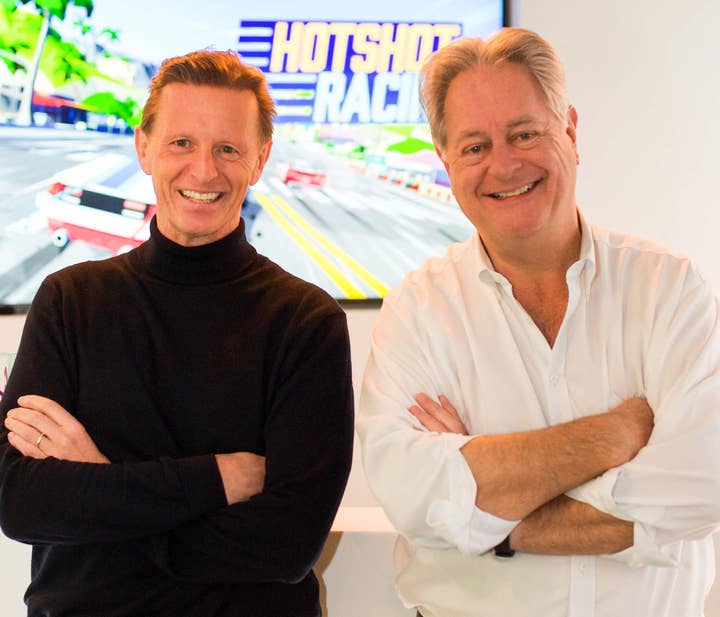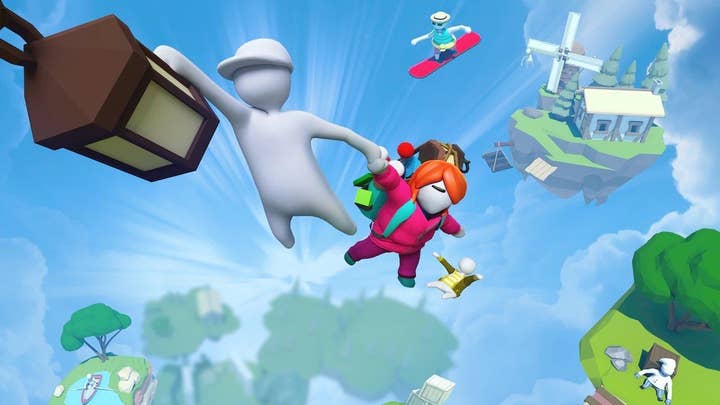Becoming the next Sega and Eidos: The transformation of Curve Games
New CEO John Clark on the vision and future of the Human: Fall Flat publisher
"What's going on at Curve?"
It's a question we've been asked a few times over the past year following the departure of CEO and co-founder Jason Perkins and publishing director Simon Byron.
During the duo's leadership at Curve, the UK publisher has grown exponentially, primarily thanks to the success of Human: Fall Flat. It received huge private equity investment at the end of 2019, and it has stated acquiring studios.
The departure of two of the company's leaders would normally be a cause for alarm, but Curve's management team today is unquestionably strong. The publisher is now led by Eidos, Sega and Tencent veteran John Clark. It's recently hired former 22Cans COO and BBC's head of games Bradley Crooks, ex-PlayStation UK marketing director and Moshi chief growth officer Rich Keen, and has just announced the hiring of Bossa and Frontier's former marketing director Jo Cooke.
"Sega does define us. There's no point in hiding that. It's factual"
"What got us here won't get us there," Clark tells us as part of an interview around Curve's latest rebrand.
"I have never started a business from scratch. I am not an entrepreneur. I am corporate. I admire anybody who has got the courage to start and build a business. I feel so honoured to be able to come to Curve at this point in time and bring my unique skillset to take it forward. But it got to where it is because of other people. That's an incredible achievement to get it into such a strong profitable company with venture backing.
"The closest I've got is launching Sega Searchlight. But if I did that with no Sega... I'm not that brave. So to come in and be the custodian of taking Curve on part two of its journey, that is something that I am incredibly grateful for. And certainly for Jason and Simon, who built Curve to what it currently is."

Clark's previous role was as VP of partnerships for Tencent in Europe, but he's best known for his 13 years at Sega Europe. It was here that he convinced Sega to release its classic games on Steam, and it was here that he developed Sega Searchlight.
Searchlight is the Sonic firm's indie publishing division. It was this department that signed Two Point Hospital and acquired Two Point Studios. Clark was the leader of the four-person team that founded the department, and three of that team are now at Curve.
"Oh it's absolutely fair to say [Curve is] a bit like a new Sega Searchlight.
"The most important part of my Sega career was transitioning into a developer-led digital global publisher. The second most important thing was setting up Sega Searchlight. And the third most important thing I did was bring Japanese content to Steam. We were pioneers. Those three things were the most satisfying and meaningful contributions I have made in my career. We are lifting all of that up and putting it into Curve.
"To me, what makes a great publisher is the ability to find and launch great games. In terms of launching great games, I have the core team that helped me drive that transition at Sega, who launched games globally and worked with great studios. We also found great studios. If you think about Sega Europe being five studios... you can tie my team directly to the acquisition of four of those. So yes, Sega does define us. There's no point in hiding that. It's factual."
'The new Sega' comes a few years after Curve was positioning itself as 'the new Eidos' (the UK publisher of Tomb Raider and Hitman, which was acquired by Square Enix in 2009). This is partly because the CEO of Curve's parent company Catalis is Eidos founder Dominic Wheatley. And Clark also spent some time at Eidos, too.
"If I think back to Eidos, we were able to launch games like [simulation strategy game] Startopia, and we were able to launch games like Tomb Raider," says Clark. "That was brilliant, and it shows AAA and indie all in the same place."
So is the dream for Curve to push into the AAA space?
"It's about the developer. We want to understand what the developer vision is. If their vision is to develop a Kickstarter-level game that is made by one person that wants moderate success, and we love that game, we want to be its publisher.
"If the vision is to significantly break new ground and launch the next TimeSplitters, we want to be that publisher. And then it's about how we take it to market, make it relevant and add value.
"Is it my vision to be the next Eidos? Yeah, but that doesn't mean we want to just do Tomb Raiders. We want to do Startopias as well. And even Sega, it wasn't just about doing Total Wars, we wanted to do Two Point Hospital as well. But it's all down to the developer."

Late last year, Curve Digital became Curve Games. Clark says that this represents a 'brand new company', and that the changes go beyond some new faces and a new logo.
"[When I joined] we needed to think about how to keep the business healthy, to keep growing, to keep developer relations healthy, to keep relevant and pioneering... and to keep us in the position to find the next Human Fall Flat or Fall Guys, without being over-reliant on doing that.
"That comes down to three main things. Firstly, it's your culture, in terms of people enjoying coming to work every day. Secondly, it's your process. Every business needs a process in order to align with each other and ensure we are an efficient publisher that adds value to the partners that we work for. And the last bit is around how we're structured, how we're organised, how we talk to each other and how we take responsibility for our collective efforts.
"Since day one, I've been evaluating all three of those. What's the culture like and what does it need to be to support the growth trajectory? Do we have processes and leadership and structure for a two-games-a-year indie, or a ten-games-a-year indie? And these are the changes you're seeing."
The company is certainly transforming. Clark and his team is tasked with growing Curve to the point that it can follow the likes of Team17, Devolver and TinyBuild, and either float on the stock market or be acquired. Yet for all the changes, Curve's defining success -- even today -- remains the continued popularity of its flagship game: Human: Fall Flat.
"All the games that I've associated myself with... Tomb Raider, Mario & Sonic, Lego Star Wars [...] Human: Fall Flat outsold all of those"
"I've talked a lot about the rebrand, the people we've brought in... and we've launched great games this year. But it's important to say, Jason and Simon built an incredible business. The roadmap, the catalogue, the success, the profitable growth... the games we've launched this year were games that were here before I joined. And Human: Fall Flat was part of that.
"When I think about all the games that I've associated myself with... Tomb Raider, Mario & Sonic, Lego Star Wars... Who Wants To Be A Millionaire, that was a big hit. Championship Manager. But Human: Fall Flat outsold all of those. The experience of being there and understanding how it happened... you can't plan for this success, but when you get traction you can respond. It's something Curve has done brilliantly.
"Human: Fall Flat is in its fifth year. It's had 18 free updates. So every single sale of this four-and-a-half year-old game, 30 million copies, has been kept alive through free content and events. It's important to have that experience in things like that, and then taking that experience and making it valuable to your partners
"How many publishers have their nose that close to the ground so that they are in the right place at the right time to find the next indie hit developed by two, three, four, five developers? There are not many. It doesn't matter how active you are, or whether you're Embracer, Tencent, Microsoft or Sega, when you're looking at investments, it is really hard to get close to the ground to be there when an indie hit breaks out. It's important that we stay there. So we can find those games.
"And then it's about knowing what it takes. Curve knew how to respond and how to get that game from 0 to 30 million. Human: Fall Flat is in the Top 20 games. But how many publishers are there across those 20 games? And how many of those are indie games? There's four: Terraria, PUBG, and Minecraft, alongside Human: Fall Flat. When I talk about available publishing expertise that other people can use... out of those four, it's really just Curve."

Throughout the interview, Clark repeats the term 'what got you here won't get you there.' He is talking about Curve's journey, but he could be talking about any business or any individual working in games today. Clark's personal journey took him from being someone who worked for a publisher-led retail business to a developer-led digital business. But the industry never sits still. This past week, Microsoft's acquisition of Activision Blizzard signals that more change is coming in terms of how games are bought and sold.
Clark says Curve is ready for it.
"When we think about the incumbents in the games industry, you think of Sony, Nintendo, Microsoft, Steam... once upon a time, Steam wasn't in that group. Within that there have always been new initiatives or new people coming in.
"There was a moment a few years ago where a number of things happened. Google Stadia, Game Pass, Epic Game Store.. it felt like all of those initiatives breaking was going to be a significant moment. We had to take notice. These are serious players. And now we've got Netflix and Amazon developing a bigger games business.
"All this needed to be taken seriously, and it's being taken serious by Curve. We see ourselves as a company that releases premium PC games on Steam. And then taking that and rolling it across all the consoles format, all the business models... going from single-player to multiplayer. Adding cross-play. Adding user-generated content. Adding community elements. Going to mobile. Building an audience in different geographies, like China. All of this needs to be taken seriously.
"It's about taking our core game, our core idea, and see how it can map itself across all the incredible initiatives and developments out there. That's reflected in the team we built. These are people who understand these initiatives. We have done all this before."
He concludes: "It's unknown, but it's happening. If we don't embrace it... if you go back 15 years, if you said I don't believe in streaming TV shows, I still believe in DVD, I still believe in Blockbuster... there's a way we need to think, which is all about the player and what works for them."

